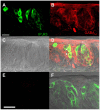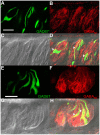Expression of GABAergic receptors in mouse taste receptor cells
- PMID: 21049022
- PMCID: PMC2964312
- DOI: 10.1371/journal.pone.0013639
Expression of GABAergic receptors in mouse taste receptor cells
Abstract
Background: Multiple excitatory neurotransmitters have been identified in the mammalian taste transduction, with few studies focused on inhibitory neurotransmitters. Since the synthetic enzyme glutamate decarboxylase (GAD) for gamma-aminobutyric acid (GABA) is expressed in a subset of mouse taste cells, we hypothesized that other components of the GABA signaling pathway are likely expressed in this system. GABA signaling is initiated by the activation of either ionotropic receptors (GABA(A) and GABA(C)) or metabotropic receptors (GABA(B)) while it is terminated by the re-uptake of GABA through transporters (GATs).
Methodology/principal findings: Using reverse transcriptase-PCR (RT-PCR) analysis, we investigated the expression of different GABA signaling molecules in the mouse taste system. Taste receptor cells (TRCs) in the circumvallate papillae express multiple subunits of the GABA(A) and GABA(B) receptors as well as multiple GATs. Immunocytochemical analyses examined the distribution of the GABA machinery in the circumvallate papillae. Both GABA(A)-and GABA(B)- immunoreactivity were detected in the peripheral taste receptor cells. We also used transgenic mice that express green fluorescent protein (GFP) in either the Type II taste cells, which can respond to bitter, sweet or umami taste stimuli, or in the Type III GAD67 expressing taste cells. Thus, we were able to identify that GABAergic receptors are expressed in some Type II and Type III taste cells. Mouse GAT4 labeling was concentrated in the cells surrounding the taste buds with a few positively labeled TRCs at the margins of the taste buds.
Conclusions/significance: The presence of GABAergic receptors localized on Type II and Type III taste cells suggests that GABA is likely modulating evoked taste responses in the mouse taste bud.
Conflict of interest statement
Figures










Similar articles
-
Acid stimulation (sour taste) elicits GABA and serotonin release from mouse taste cells.PLoS One. 2011;6(10):e25471. doi: 10.1371/journal.pone.0025471. Epub 2011 Oct 20. PLoS One. 2011. PMID: 22028776 Free PMC article.
-
GABA expression in the mammalian taste bud functions as a route of inhibitory cell-to-cell communication.Proc Natl Acad Sci U S A. 2009 Mar 10;106(10):4006-11. doi: 10.1073/pnas.0808672106. Epub 2009 Feb 17. Proc Natl Acad Sci U S A. 2009. PMID: 19223578 Free PMC article.
-
GABA, its receptors, and GABAergic inhibition in mouse taste buds.J Neurosci. 2011 Apr 13;31(15):5782-91. doi: 10.1523/JNEUROSCI.5559-10.2011. J Neurosci. 2011. PMID: 21490220 Free PMC article.
-
How taste works: cells, receptors and gustatory perception.Cell Mol Biol Lett. 2015 Dec;20(5):699-716. doi: 10.1515/cmble-2015-0042. Cell Mol Biol Lett. 2015. PMID: 26447485 Review.
-
Taste buds as peripheral chemosensory processors.Semin Cell Dev Biol. 2013 Jan;24(1):71-9. doi: 10.1016/j.semcdb.2012.12.002. Epub 2012 Dec 20. Semin Cell Dev Biol. 2013. PMID: 23261954 Free PMC article. Review.
Cited by
-
Acid stimulation (sour taste) elicits GABA and serotonin release from mouse taste cells.PLoS One. 2011;6(10):e25471. doi: 10.1371/journal.pone.0025471. Epub 2011 Oct 20. PLoS One. 2011. PMID: 22028776 Free PMC article.
-
Taste receptor signalling - from tongues to lungs.Acta Physiol (Oxf). 2012 Feb;204(2):158-68. doi: 10.1111/j.1748-1716.2011.02308.x. Epub 2011 May 7. Acta Physiol (Oxf). 2012. PMID: 21481196 Free PMC article. Review.
-
Role of neurotrophin in the taste system following gustatory nerve injury.Metab Brain Dis. 2015 Jun;30(3):605-13. doi: 10.1007/s11011-014-9626-0. Epub 2014 Nov 9. Metab Brain Dis. 2015. PMID: 25381474 Review.
-
Delving into the reducing effects of the GABAB positive allosteric modulator, KK-92A, on alcohol-related behaviors in rats.Alcohol. 2023 Nov;112:61-70. doi: 10.1016/j.alcohol.2023.07.004. Epub 2023 Jul 24. Alcohol. 2023. PMID: 37495087 Free PMC article.
-
Tachykinins stimulate a subset of mouse taste cells.PLoS One. 2012;7(2):e31697. doi: 10.1371/journal.pone.0031697. Epub 2012 Feb 21. PLoS One. 2012. PMID: 22363709 Free PMC article.
References
-
- Delay RJ, Roper SD. Ultrastructure of taste cells and synapses in the mudpuppy Necturus maculosus. J Comp Neurol. 1988;277:268–280. - PubMed
-
- Kinnamon JC, Sherman TA, Roper SD. Ultrastructure of mouse vallate taste buds: III. Patterns of synaptic connectivity. J Comp Neurol. 1988;270:1–10, 56-17. - PubMed
-
- Finger TE, Danilova V, Barrows J, Bartel DL, Vigers AJ, et al. ATP signaling is crucial for communication from taste buds to gustatory nerves. Science. 2005;310:1495–1499. - PubMed
Publication types
MeSH terms
Substances
Grants and funding
LinkOut - more resources
Full Text Sources
Molecular Biology Databases

